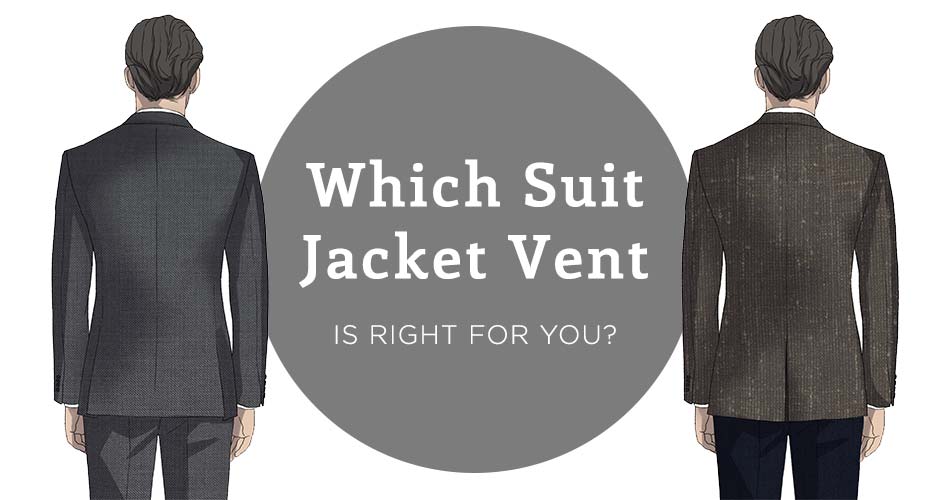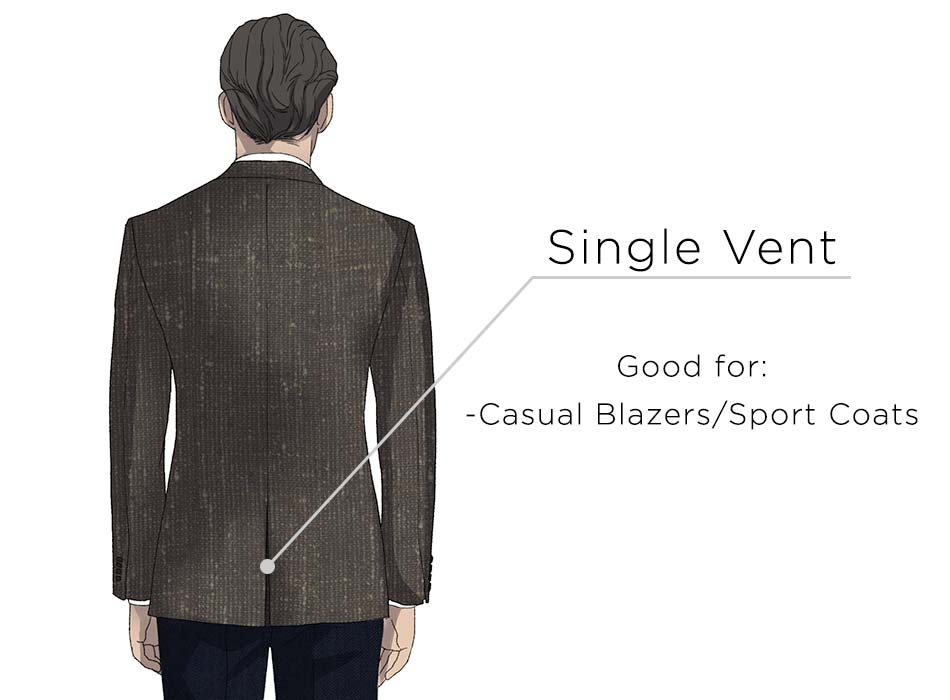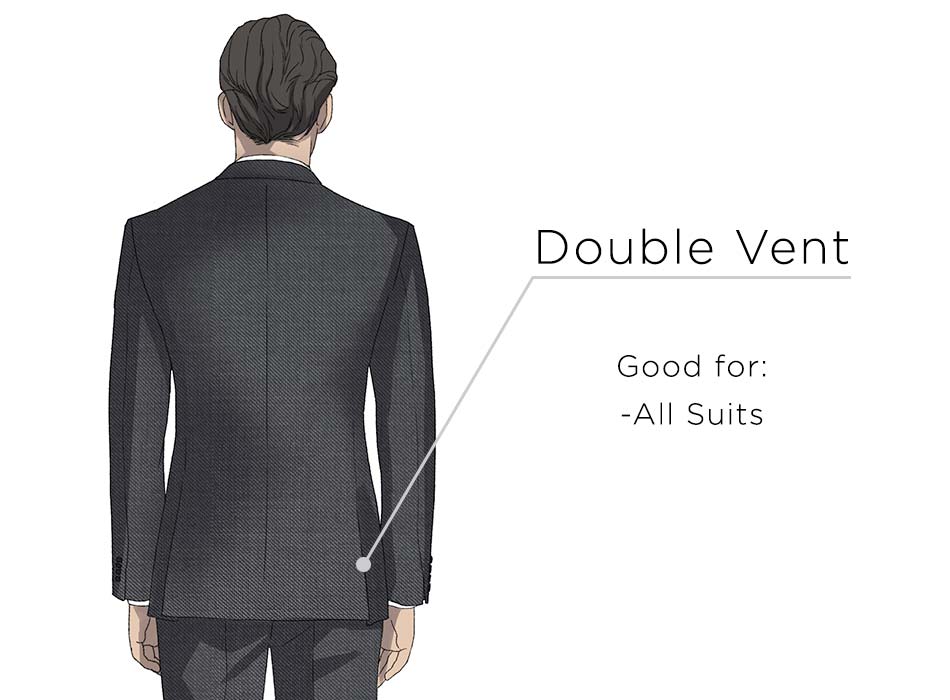Suit Vents: A Guide to Understanding the 3 Types

Which Suit Jacket Vent Is Right For You?
The suit maketh the man and the details maketh the suit. From the buttons to the lapel types to the pockets, it’s been well documented that the front of a suit jacket is rich with opportunities to make choices that add a personal touch. On top of its potential for customization, the front of the suit is the part you most often see when admiring your dapper self in the mirror and in photographs. But that’s just you. Other people have to look at the back of your suit too. And there’s a key design feature in the back that deserves a bit of your attention, specifically, the part covering your derrière: suit jacket vents.
What Are Suit Vents?
For the uninitiated, a suit vent is a vertical slit that extends upward from the bottom hem on the backside of a suit jacket or blazer. (If you need to, learn the differences between a suit jacket and a blazer.)
Suit vents became a distinguishing feature on jackets back when gentlemen in polite society spent their leisure time enjoying equestrian pursuits. While riding their trusted steed, these additional openings in the jacket allowed for ease of movement and greater comfort in the saddle. The separation created by these openings also helped the jacket drape more gracefully over the sides of the rider’s hips, rather than bunching or creasing around the seat.
Today, few among us are suiting up for this high society purpose, but your choice between the types of suit vents remains a staple decision in traditional tailoring. Their functional purpose remains largely unchanged: suit vents reduce the feeling of constriction while moving or sitting, prevent the fabric from bunching, and offer smooth access to your pant pockets that don’t mar the lines of the jacket when you go fishing for loose change.
Why Does The Jacket Vent Matter?
Much like suit pant breaks, some personal preference is involved in selecting the vent style for your jacket. Suit vents commonly appear in two configurations: a single, centered vent or double-sided vents (there’s a third no vent option on certain jackets, but let’s leave that aside for now).
You could, in theory, simply pick the look you personally find most aesthetically pleasing and strut off into the sunset. That would be a rookie move because as is so often the case in the world of suits, there are threads of meaning sewn into every choice you make.
The 3 Types Of Suit Vents
Your answer to the age-old “Center vent or double vent?” question can signal whether you’re a more modern or a more traditional gent. A discerning eye might also see it as an indication of the provenance of your suit. Though honestly, the choice between the type of suit vent to choose mostly comes down to the fact that different styles flatter different body types, and fit (especially how your suit should fit) is king — this we know.
Let’s get to it.
Single Suit Vent

A single jacket vent sits directly in the center back of the jacket hem. Since gaining popularity with Ivy League types in the mid-20th century, the single jacket vent is often considered the ‘American style’ and is very common among the American workplace, particularly among baby boomers and older gents. It can also be found on more casual blazers given its simpler aesthetic.
The case for the single vent begins with availability. It is more readily available off-the-rack, as a jacket with a single vent is faster, easier and less expensive for mass market manufacturers to make. As far as fit and aesthetic, its omnipresence means a single vent can be the more comfortable choice for guys who aren’t used to dressing in attention-getting styles. Single vent jackets will also be more flattering for the larger man, or more specifically, the man with extra junk in his trunk as side vents can flare out in ways that some consider distracting.
Our Verdict: The single suit vent is an all-purpose style that can look sharp as long as the fit is right on the rest of the suit, but it won’t impress the dandy set. It can be appropriate on a more casual blazer.
Double Suit Vents

The double jacket vent (or side vents) features twin openings that sit on each side of the jacket’s back hem.
Suits with double jacket vents are commonly associated with British tailoring lineage, giving the wearer a more sophisticated and European flair in their style. Double-vented jackets naturally require more time and more cost to produce. As such, they tend to be found more frequently on made-to-measure or bespoke suits as well as occasionally, on premium ready-to-wear suit brands.
This air of exclusivity makes the double vent an ideal choice for the guy who wants to stand out and be seen as style-savvy. Most body types, other than the one mentioned above, will find this style flattering.
Our Verdict: The double jacket vent is a more sophisticated and stylish option and is our preferred look for most gents here at Black Lapel.
Ventless Jacket

Now to reveal what’s behind door number three. The third and final suit vent option is not much of an option at all — a ventless jacket.
The vent-free jacket features an unbroken silhouette that is only ever appropriate with formalwear. Specifically, on the backs of a tuxedo jacket. Brush up on the differences between a tuxedo vs. suit jacket to learn more about why this is the case.
Our Verdict: The ventless jacket is a handsome and classic choice for black tie and only black tie.
Assets = Covered
Now that you know the types of suit vents available and how to choose between them. So, you can rest easy knowing the back of your suit looks just as good as the front.
Have any suit vent questions we didn’t cover? Drop a comment below and we’ll get back to you with an answer! Or just say hi, we like that too.
Your Next Move:
Like What You See? There's More.
We'll send you style advice and intel for the modern man.





Single vented suit jackets are more clean, conservative and understated. Proper for everyday business or if you are invited to a WASP American cocktail party. Flat to robust derrière.
Double vented suits exudes elegance and flare and that extra panache. Excellent for men who what to stand out or are style savvy. Flat to medium derrière.
No vented suit jackets rooted and made popular by Italian fashion houses and mobsters in the 20’s thru 40’s. Again in the 80’s and 90’s. One could pull it off only if you are tall and thin. Flat derrière only.
At the end of the day know your body type. It comes down to one’s preference. Remember what one is most comfortable wearing will exude one’s confidence.
I would need to buy suits, nice fabric, single jacket vents, two piece
I would need to buy suits, nice fabric, single jacket vents
Hey, don’t you think that men with slim figure may better look wearing ventless and with one vent jackets. Whereas two vents jackets may hide all imperfections ?
Are you supposed to cut the white X thread on the suit vents???
Buying a suit to order and disco days are over. Sons getting married and I have to look the part 1 2 or no vent thinking 2 vents. What about buttons on sleeve and vest with Lapel Yah or nay
Whatever you decide vent, no vent you must feel good wearing it
Personally, and as a bespoke cutter and tailor, I have always found that a jacket cut just below the buttocks will not need a vent. A ventless jacket, as some have already noted, does look more slimming. As for single vents, I’ve always found that a shorter vent (8″-10″) is better for both appearance and working purposes, rather than running all the way to the waist.
That said, a vent does NOT mean one can wear a jacket that doesn’t have sufficient coverage over the hips and buttocks, such that the vent(s) gape open. This goes double, literally, for double vents. There are perhaps two reasons to avoid them, all construction issues aside which also assumes the tailor made/shaped them properly: 1) their placement on contemporary jackets at the “corners” of the body means they will inevitably gap and stand away, even on a correctly fitted jacket, and 2) they tend to emphasize the size of one’s backside, both in their placement and just that they draw attention to themselves. I suppose that, thirdly, when placed on English-cut (i.e. flared hip) jackets, which is most common, the double vents perforce always stand away from the body.
My points are not going to dissuade those who like certain styles, but it’s important to understand certain realities.
Should I choose my suit vent according to my waist length, buttocks length and the curve they make?
Thanks you
Double vented jackets are the equivalent of long underwear with butt flaps. If sophistication means “ease of relief” then a double vent is your goto. When gentlemen invented the vent they cut the thing up the middle so that each side rested and conformed to its respective side. Double vents are lazy, ergo fits most body types. The sell of it being more sophisticated is laughable.
The mods of the 1960s favoured side vents, and it was important to specify the length of vent when instructing your tailor. I had a suit made by John Temple, advertised as a John Steed suit, that instead had a single centre pleat. I have never been able to find a picture of such a suit online.
On western T.v. shows. The sports coats they wear there are usually TWO BUTTONS just above the vents on the back of the jacket. Do those buttons serve a function it are they purely for aesthetics?
I’ve searched and searched and can’t find a viable answer.
Can a jacket without vent cant be converted into double vents ?
Are longer double back vents a good style statement. I see some jackets have longer vents and I find it more stylish.
It’s ridiculous to say that a ventless jacket is only appropriate for formal wear. The ventless look was standard during the heyday of double-breasted suits in the 1930s & 40s and their revival in the 1980s & 90s. It can work for dressier single-breasted suits as well (although I would agree it doesn’t for more casual sports coats or blazers). And as Stu points out, the ventless look provides a more flattering silhouette for many men. The fact that everything seems to be double-vented today, regardless of style or whether a ventless option would be better/suitable, is frustrating.
It’s ridiculous to say that a ventless jacket is only appropriate for formal wear. The ventless look was standard during the heyday of double-breasted suits in the 1930s & 40s and their revival in the 1980s & 90s. It can work for dressier single-breasted suits as well (although I would agree it doesn’t for more casual sports coats or blazers). And as Stu points out, the ventless look provides a more flattering silhouette for many men. The fact that everything seems to be double-vented today, regardless of style or whether a ventless option would be better/suitable, is frustrating.
I love the elegant look of the thirties and the closed vent look. I am a slender person and from the side angle the double vent doesn’t lay clean. Single vent is out of the question.
Good explanation of the options. I’m locked into a center vent because I wear a belt holster at the 4:00 o’clock position, and double vents don’t adequately conceal that. I usually wear custom suits, but sometimes picked up something off the rack until they were all increasingly double vented.
I have no behind
snd find that ventless/no vent gives me a more flattering look (in my opinion)
Yup! Most of it really comes down to personal preference. Everyone has their own style, and that is what we love about menswear!
I am slim and have no behind
I find that the no bent option gives me sliminng look.
Are double vents cooler in hot weather than a single vent?
Hey Charles! There isn’t enough of a ventilation difference between the two to warrant one being better than the other for temperature related reasons.